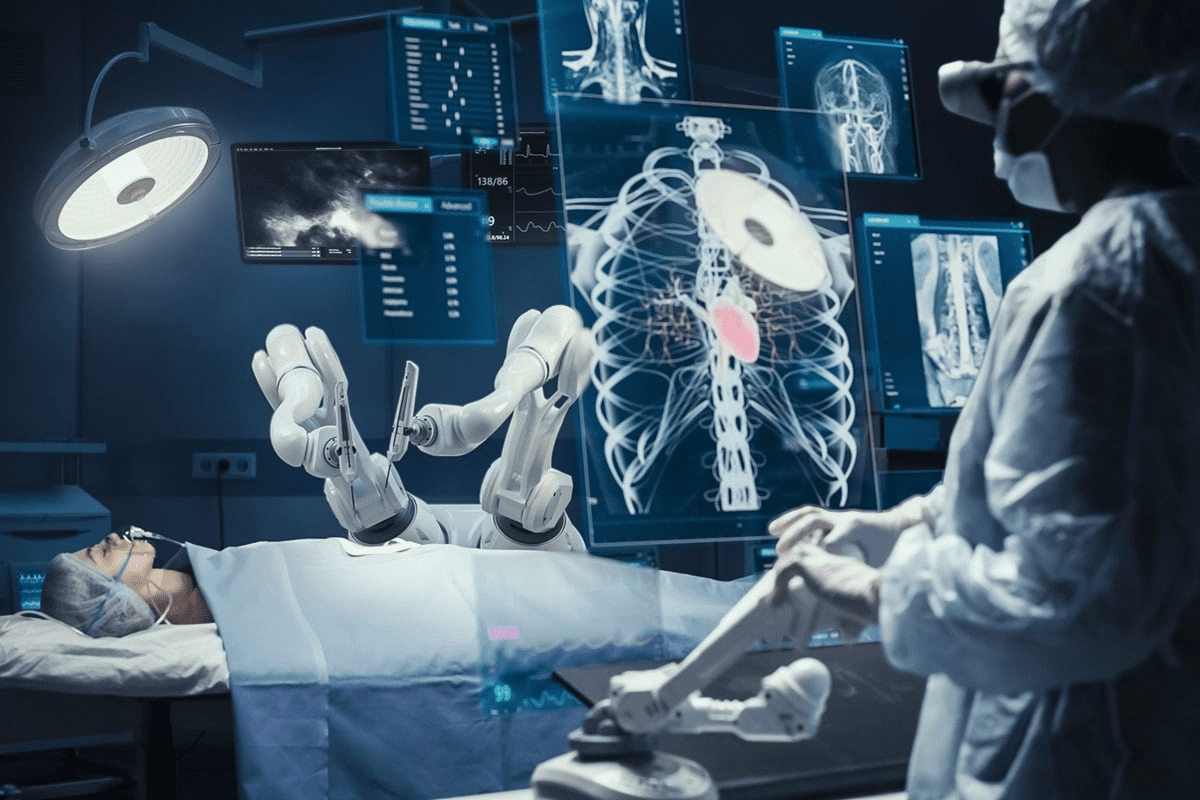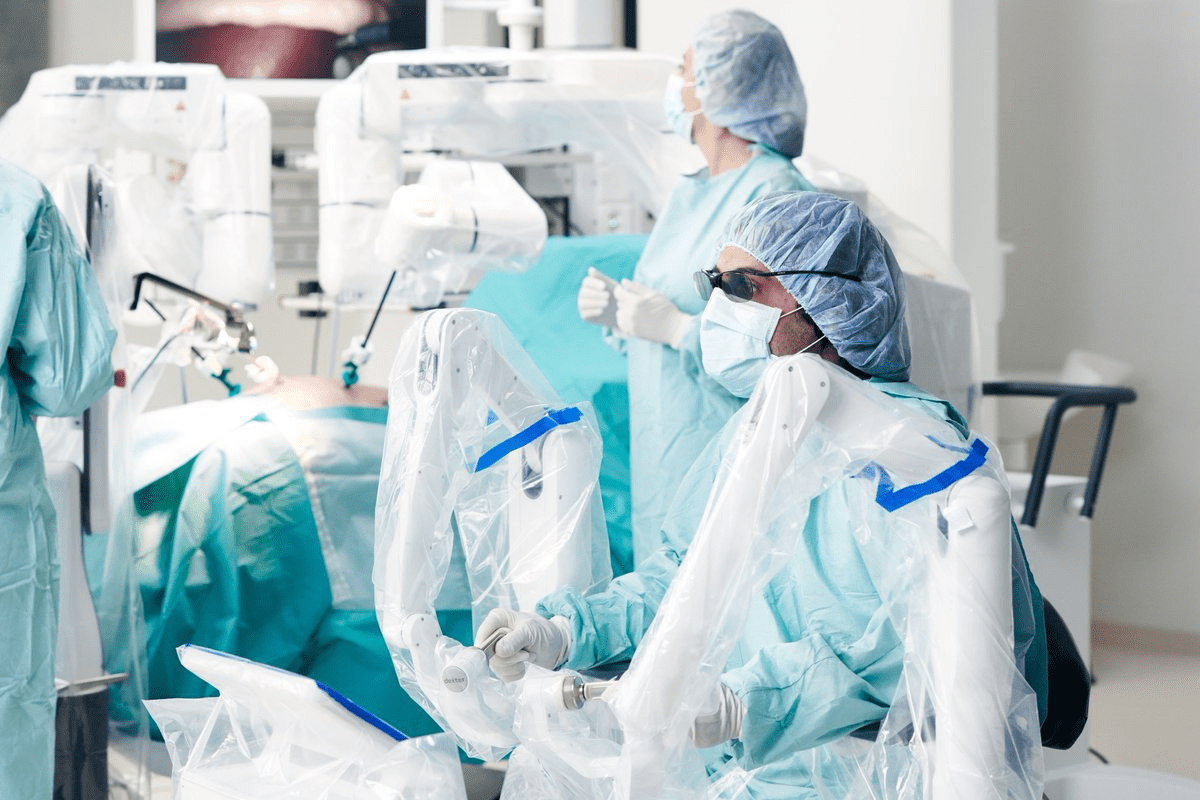Where does ovarian cancer usually start? Ovarian cancer is a complex disease with many subtypes and origins. Studies have found that it can start from different cell types and tissues. These include the ovarian surface epithelium and the fallopian tubes.
Knowing where ovarian cancer starts is key to finding better ways to prevent and treat it. Our team of experts is committed to giving top-notch healthcare. We also offer full support for patients from around the world.

Key Takeaways
- Ovarian cancer can arise from different cell types and tissues.
- The ovaries and fallopian tubes are possible origins of ovarian cancer.
- Understanding where ovarian cancer starts is vital for good prevention and treatment.
- Our team provides full support for patients from other countries.
- Good treatment plans depend on knowing the disease’s origin.
Understanding the Ovaries: Anatomy and Function
The ovaries are key parts of the female body. They make eggs and hormones needed for making babies. Located in the pelvis, they are vital for the female cycle.
Anatomical Structure of the Ovaries
The ovaries have a special structure that helps them work. They have epithelial cells, germ cells, and stromal cells. The outer layer is covered by epithelial cells. Inside, germ cells turn into eggs, and stromal cells make hormones.
They also have a protective capsule. Knowing how the ovaries are built is key to understanding ovarian cancer.
Physiological Functions in the Female Reproductive System
The ovaries do many important jobs. They mainly make eggs (oocytes) for ovulation. This is how babies can be made. They also make hormones like estrogen and progesterone.
These hormones control the menstrual cycle and help with pregnancy. The ovaries’ hormone-making cells are very important. They keep the reproductive system working right.
The Cellular Origins of Ovarian Cancer
Ovarian cancer can start from different cell types, like epithelial, germ, and stromal cells. Knowing where ovarian cancer comes from is key to finding better treatments.
Epithelial Cells: The Most Common Starting Point
Most ovarian cancers start in epithelial cells. These cells cover the outside of the ovary and can turn cancerous. Epithelial ovarian cancer is the most common type.
- Epithelial cells can turn cancerous due to genetic changes or environmental factors.
- These cells can fold inward to form inclusion cysts. These cysts might lead to some types of epithelial ovarian cancer.
Germ Cells and Stromal Cells as Origins
While most cancers start in epithelial cells, some start in germ cells and stromal cells. Germ cells make eggs, and stromal cells make hormones that help the ovary work.
Germ cell tumors start in egg-producing cells. They are more common in young women and can be either benign or malignant.
- Germ cell tumors can be several types, like dysgerminoma and yolk sac tumor.
- Stromal tumors start in the hormone-making cells of the ovary.
It’s important to understand where ovarian cancer comes from. This knowledge helps doctors find better treatments and improve patient care.
Ovarian Cancer Origin: Current Scientific Understanding
The start of ovarian cancer has been a mystery for a long time. New studies are helping us understand it better. Our view of ovarian cancer has changed a lot, from simple to complex.
Evolution of Theories About Ovarian Cancer Origins
At first, people thought ovarian cancer came from the surface of the ovaries. But now, we know it can start in different places. This includes the fallopian tubes.
The discovery of serous tubal intraepithelial carcinoma (STIC) in the fallopian tubes changed everything. It showed that these tubes might be where high-grade serous ovarian cancer starts. This makes us think differently about how ovarian cancer begins.
Recent Research Findings on Cancer Initiation
Scientists have been studying how ovarian cancer starts. They found that genetic changes, like in BRCA1 and BRCA2, play a big role. These changes can make a person more likely to get ovarian cancer.
- Genetic Predisposition: Mutations in BRCA1 and BRCA2 significantly increase ovarian cancer risk.
- Molecular Pathways: Changes in different molecular pathways help cancer grow.
- Cell of Origin: We found that cancer can start in the fallopian tubes and the surface of the ovaries.
This new knowledge helps us understand ovarian cancer better. It also guides us in finding new ways to prevent and treat it.
The Fallopian Tube Connection: A Paradigm Shift
A growing body of evidence suggests that the fallopian tubes, not the ovaries, may be the origin of certain types of ovarian cancer.
This shift in understanding is largely based on research into the origins of high-grade serous ovarian cancer, a common and aggressive form of the disease.
Evidence Supporting Fallopian Tube Origins
Studies have shown that the fallopian tubes are a possible site for the start of ovarian cancer, mainly high-grade serous ovarian cancer.
- Histopathological analysis has revealed that many ovarian cancers contain cells that resemble those found in the fallopian tube epithelium.
- Genetic studies have identified mutations in genes such as BRCA1 and BRCA2 that are associated with an increased risk of ovarian cancer, and these mutations are also linked to fallopian tube cancer.
- Prophylactic salpingectomy (removal of the fallopian tubes) has been shown to significantly reduce the risk of ovarian cancer in high-risk individuals.
Serous Tubal Intraepithelial Carcinoma (STIC)
One of the key findings supporting the fallopian tube origin of ovarian cancer is the presence of Serous Tubal Intraepithelial Carcinoma (STIC) lesions.
STIC lesions are considered precursor lesions to high-grade serous ovarian cancer.
Key characteristics of STIC lesions include:
- Location in the fimbriated end of the fallopian tube
- Morphological and immunohistochemical features that distinguish them from normal tubal epithelium
- Genetic alterations similar to those found in high-grade serous ovarian cancer
The discovery of STIC lesions has significant implications for the early detection and prevention of ovarian cancer.
Ovarian Surface Epithelium as a Starting Point
The surface epithelium of the ovaries is a layer of cells that can turn cancerous. This layer, known as the ovarian surface epithelium, is key in ovarian cancer development.
Characteristics of Surface Epithelial Cells
Surface epithelial cells are the main source of ovarian cancer. They cover the ovaries and are involved in many body functions. Their ability to change and adapt makes them prone to cancer.
These cells can change into a form that helps them move and invade. This change is important in cancer growth.
Transformation Process from Normal to Cancerous Cells
The change from normal to cancerous cells is complex. Inflammation and oxidative stress play big roles. They cause DNA damage and mess with cell function.
| Factor | Role in Cancerous Transformation | Impact on Ovarian Surface Epithelium |
| Inflammation | Causes DNA damage and promotes malignant changes | Increases the risk of ovarian cancer |
| Oxidative Stress | Disrupts normal cellular function and DNA repair | Contributes to the initiation and progression of ovarian cancer |
| Genetic Mutations | Alters cellular behavior and promotes cancerous growth | Essential for the development of ovarian cancer |
Understanding how cells turn cancerous is key. It helps us find ways to prevent and treat ovarian cancer. By knowing the main factors, we can spot cancer early and act fast.
Different Types of Ovarian Cancer and Their Origins
Ovarian cancer is not just one disease. It’s a group of different tumors with unique origins and biology. Knowing this helps us understand the various subtypes and how to treat them.
There are several main types of ovarian cancer. Each has its own characteristics and where it starts. The main types are High-Grade Serous Carcinoma, Clear Cell and Endometrioid Carcinoma, and Mucinous Carcinoma.
High-Grade Serous Carcinoma Origins
High-Grade Serous Carcinoma (HGSC) is the most common and aggressive type of ovarian cancer. Studies show it often starts in the fallopian tube, not the ovary. The serous tubal intraepithelial carcinoma (STIC) in the fallopian tube is a precursor to HGSC.
Research found that HGSC has TP53 mutations in almost all cases. This shows how unstable its genetics are. Knowing where HGSC comes from is key to finding early detection and treatment methods.
Clear Cell and Endometrioid Carcinoma Origins
Clear Cell and Endometrioid Carcinomas are also important types of ovarian cancer. They are linked to endometriosis, suggesting they might start from endometrial tissue outside the uterus. Clear Cell Carcinoma is hard to treat because it doesn’t respond well to chemotherapy.
Endometrioid Carcinoma looks like endometrial cancer of the uterus and may come from endometriosis. Scientists are studying its molecular features, including PTEN loss and CTNNB1 mutations.
Mucinous Carcinoma Origins
Mucinous Carcinoma is a rare type of ovarian cancer. It often grows to be very large. It’s believed to start from a different cell type than other ovarian cancers, possibly from gastrointestinal-type epithelium.
Mucinous tumors are known for their mucinous differentiation and often have KRAS mutations. Their unique molecular profile might offer chances for targeted treatments.
| Ovarian Cancer Subtype | Cell of Origin | Key Molecular Features |
| High-Grade Serous Carcinoma | Fallopian tube epithelium | TP53 mutations |
| Clear Cell Carcinoma | Endometrial tissue | PTEN loss, PIK3CA mutations |
| Endometrioid Carcinoma | Endometrial tissue | PTEN loss, CTNNB1 mutations |
| Mucinous Carcinoma | Gastrointestinal-type epithelium | KRAS mutations |
Understanding the different types of ovarian cancer and where they start is key to finding effective treatments. Research into each subtype’s molecular characteristics is ongoing. This will help find new targets for therapy.
Ovarian Germ Cell Tumors: Development and Progression
To understand ovarian germ cell tumors, we need to know how they start and grow. This knowledge is key for treating them. These tumors come from egg-producing cells in the ovaries. They can be different in how they look and act.
Origins in Egg-Producing Cells
Ovarian germ cell tumors start from germ cells in the ovaries. These cells make eggs and are vital for making babies. What causes these tumors to grow is complex, involving genes and the environment.
Studies show these tumors come from germ cells that don’t develop right. Instead, they grow into tumors.
Types and Characteristics of Germ Cell Tumors
Germ cell tumors vary and are grouped by their cell type and how they look under a microscope. The main types are:
- Dysgerminoma: The most common type, often a solid mass.
- Yolk Sac Tumor: Has high levels of alpha-fetoprotein (AFP), a tumor marker.
- Teratoma: Can be benign or malignant, with different tissue types.
- Choriocarcinoma: Rare, with high levels of human chorionic gonadotropin (hCG).
| Type of Germ Cell Tumor | Characteristics | Tumor Markers |
| Dysgerminoma | Solid mass, often large | LDH |
| Yolk Sac Tumor | Aggressive, often hemorrhagic | AFP |
| Teratoma | May contain several tissue types | Varies |
| Choriocarcinoma | Rare, often metastatic | hCG |
Knowing the type and characteristics of a germ cell tumor is vital for treatment. Treatment may include surgery, chemotherapy, or both, based on the tumor type, stage, and patient factors.
Ovarian Stromal Tumors: Where They Begin
Ovarian stromal tumors start in the supportive tissue of the ovaries. They are a special kind of ovarian cancer. These tumors come from the part of the ovaries that makes hormones.
Hormone-Producing Tissue Origins
The ovarian stroma makes hormones like estrogen and progesterone. These hormones are key for the female reproductive cycle. Ovarian stromal tumors can mess with hormone levels, causing symptoms and health problems.
Studies link ovarian stromal tumors to genetic changes in hormone-making cells. These changes can cause cells to grow out of control and form tumors.
Types and Behavior of Stromal Tumors
Ovarian stromal tumors fall into several types based on their cells and how they act. The main types are granulosa cell tumors, Sertoli-Leydig cell tumors, and theca cell tumors. Each type behaves differently and has its own risk of becoming cancerous.
Granulosa cell tumors can make estrogen, causing endometrial hyperplasia and other estrogen-related issues. Sertoli-Leydig cell tumors can lead to virilization because of androgen production.
Knowing the types and behaviors of ovarian stromal tumors helps doctors treat patients better. We keep studying these tumors to get better at diagnosing and treating them.
Genetic Mutations Driving Ovarian Cancer Development
Recent studies highlight the role of genetic mutations in ovarian cancer. They suggest new ways to detect and treat the disease early. Ovarian cancer is a genetic disease caused by mutations that disrupt cell growth and division.
These mutations can be inherited or occur during a person’s life. Inherited mutations come from parents, while acquired ones happen due to environmental factors or DNA errors.
BRCA1 and BRCA2 Mutations
BRCA1 and BRCA2 mutations are well-known in ovarian cancer. These genes help fix damaged DNA. Mutations in them can lead to a higher risk of cancer.
Women with these mutations face a higher risk of ovarian cancer. The risk is about 40-50% for BRCA1 and 20-30% for BRCA2.
Other Genetic Alterations in Ovarian Cancer
Other genetic changes also play a big role in ovarian cancer. Mutations in genes related to DNA repair and cell cycle can cause cancer.
| Gene | Function | Impact on Ovarian Cancer |
| BRCA1 | DNA repair | Increased risk of ovarian cancer |
| BRCA2 | DNA repair | Increased risk of ovarian cancer |
| TP53 | Tumor suppression | Commonly mutated in high-grade serous ovarian cancer |
Understanding these genetic changes is key to better treatments. Genetic testing helps identify those at high risk. This allows for early intervention and prevention.
As we learn more about ovarian cancer’s genetics, we’re getting closer to better prevention and treatment. Using genetic information in medicine is changing how we manage ovarian cancer. It brings new hope to patients and their families.
Hormonal Influences on Ovarian Cancer Formation
Research shows that hormones like estrogen and progesterone are key in ovarian cancer. Knowing how these hormones work is important for fighting the disease.
Estrogen and Progesterone Effects
Estrogen and progesterone are vital in the female body. They affect how ovarian cancer develops.
- Estrogen’s Role: Estrogen makes cells divide, which can lead to cancer.
- Progesterone’s Impact: Progesterone’s effect on cancer risk is complex. It depends on how and when it’s present.
Hormonal Risk Factors Throughout a Woman’s Life
Many hormonal events in a woman’s life can change her risk of ovarian cancer. These include:
- Menstrual History: Starting menstruation early or stopping late means more ovulations. This might increase cancer risk.
- Pregnancy and Childbirth: Being pregnant young or having many children might lower cancer risk.
- Hormone Replacement Therapy (HRT): Using HRT, like estrogen-only therapy, can raise cancer risk.
Knowing about these hormonal effects and risks helps in making better prevention plans. It also improves treatment for ovarian cancer.
Environmental and Lifestyle Factors in Ovarian Cancer Initiation
Studies have found that environmental and lifestyle factors greatly affect ovarian cancer risk. Knowing about these factors is key to preventing the disease.
Inflammation and Oxidative Stress
Chronic inflammation and oxidative stress play big roles in starting ovarian cancer. Inflammation can cause genetic changes in ovarian cells. Oxidative stress damages cells, which can lead to cancer.
- Inflammation comes from infections and environmental factors.
- Oxidative stress happens when the body can’t handle reactive oxygen species.
External Exposures and Their Impact
Exposure to certain chemicals and pollutants raises ovarian cancer risk. For example, talc and some industrial chemicals are linked to higher risks.
- Using protective gear and following safety rules can lower chemical exposure.
- Healthy eating and not smoking can also help reduce risk.
Understanding how environment and lifestyle affect ovarian cancer helps us prevent and detect it early.
Early Detection Challenges: Why Origin Matters
Knowing where ovarian cancer starts is key to finding it early. It’s hard to spot ovarian cancer early because of its complex origins. We must look into the hurdles of early detection and how knowing its origins helps.
Difficulties in Screening Based on Origin Sites
Ovarian cancer can start in the ovaries, fallopian tubes, or nearby tissues. This makes it tough to find one screening test for all. We face many challenges in screening, including:
- Multiple possible start sites: Ovarian cancer can begin in different places, making a universal test hard to create.
- Lack of clear early signs: Ovarian cancer often shows vague symptoms, making it hard to detect early based on symptoms alone.
- Current screening’s limits: Today’s tests, like ultrasound and CA-125 blood tests, aren’t perfect for catching early-stage disease.
Biomarkers Related to Cancer Origin
Biomarkers are vital for spotting ovarian cancer early. Scientists are looking into biomarkers linked to ovarian cancer’s origins. Some promising areas include:
- Finding specific genetic mutations tied to different ovarian cancer types.
- Creating biomarker panels to catch ovarian cancer early, even before symptoms show.
- Studying epigenetic changes as early detection markers.
By understanding where ovarian cancer starts and finding the right biomarkers, we can better detect it early. This could help lower death rates from this disease.
Preventive Strategies Based on Origin Understanding
Research is helping us understand where ovarian cancer starts. This knowledge lets us create better ways to prevent it. Knowing where ovarian cancer comes from is key to making prevention plans work.
Risk-Reducing Surgeries
Women with high-risk genes like BRCA1 and BRCA2 might choose risk-reducing surgeries. These surgeries remove the ovaries and sometimes the fallopian tubes. It’s a big decision that needs careful thought.
Studies show these surgeries can lower ovarian cancer risk. For example, a study published in a medical journal found they greatly reduce risk in BRCA1 and BRCA2 carriers.
| Surgery Type | Risk Reduction | Considerations |
| Risk-Reducing Salpingo-Oophorectomy (RRSO) | Up to 90% reduction in ovarian cancer risk for high-risk individuals | Involves removal of ovaries and fallopian tubes; impacts hormone production and fertility |
| Prophylactic Salpingectomy | Potential reduction in ovarian cancer risk, specially for serous cancers | Removal of fallopian tubes; may be considered for women with high-risk genetic mutations |
Targeted Prevention for High-Risk Individuals
Women at high risk of ovarian cancer need special prevention plans. These might include regular tests, medicine to prevent cancer, and healthy lifestyle choices. Finding out who’s at high risk involves looking at their genes, family history, and other factors.
Women with certain genetic mutations face a higher risk. For them, more frequent tests and other preventive steps can help.
By knowing where ovarian cancer starts and who’s at risk, we can do better to stop it. This tailored approach could greatly lower ovarian cancer rates.
Conclusion: The Importance of Understanding Ovarian Cancer Origins
Knowing where ovarian cancer starts is key to fighting it. We’ve looked into how this disease begins, from cells to different types. Each type has its own start point.
Understanding where ovarian cancer begins helps us find better ways to stop it early. Our team works hard to find new ways to fight this disease. We want to help those affected by sharing the latest research and information.
It’s very important to know how ovarian cancer starts. As we learn more, we can help more people. This includes those looking for top-notch medical care and support.
FAQ
Where does ovarian cancer usually start?
Ovarian cancer can start in different parts of the female reproductive system. This includes the ovaries, fallopian tubes, and surrounding tissues. Some research suggests it may start in the fallopian tubes.
What are the different cell types that can give rise to ovarian cancer?
Ovarian cancer can come from three main cell types. These are epithelial, germ, and stromal cells. Epithelial cells are the most common source. Germ cell tumors are rare and often found in younger women.
What is the role of genetic mutations in ovarian cancer development?
Genetic mutations, like BRCA1 and BRCA2, are key in ovarian cancer. They increase the risk and are linked to family history.
How do hormonal influences affect ovarian cancer formation?
Hormones like estrogen and progesterone play a role in ovarian cancer. Research shows that reproductive history and hormone therapy can affect risk.
What are the environmental and lifestyle factors that contribute to ovarian cancer initiation?
Environmental and lifestyle factors, such as inflammation and oxidative stress, can start ovarian cancer. Diet, smoking, and chemical exposure also play a part.
Why is understanding the origin of ovarian cancer important for prevention and treatment?
Knowing where ovarian cancer starts is key for prevention and treatment. It helps us find high-risk individuals and create targeted therapies.
What are the challenges of early detection in ovarian cancer?
Finding ovarian cancer early is hard because of no clear symptoms or screening methods. Knowing where it starts helps find early biomarkers.
What preventive strategies are available for ovarian cancer based on origin understanding?
There are preventive strategies like risk-reducing surgeries for high-risk individuals. Understanding the origin helps identify who needs these strategies.
How do ovarian germ cell tumors develop and progress?
Ovarian germ cell tumors come from egg-producing cells. They can be benign or malignant and often affect younger women.
What are the characteristics of ovarian stromal tumors?
Ovarian stromal tumors come from hormone-producing tissues. They can produce hormones and may be benign or malignant.
What is the significance of serous tubal intraepithelial carcinoma (STIC) in ovarian cancer?
STIC is a precursor to high-grade serous ovarian cancer. It may be an early sign of ovarian cancer risk.






